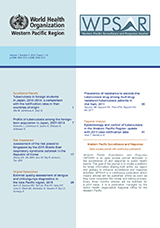Profile of tuberculosis among the foreign-born population in Japan, 2007–2014
DOI:
https://doi.org/10.5365/wpsar.2016.7.1.008Abstract
The proportion of foreign-born people among the newly notified tuberculosis (TB) patients has been increasing in recent years and potentially poses a new challenge to TB control in Japan. In this report, we analysed the data from the Japan TB surveillance system between 2007 and 2014 to gain an overview of the trends and characteristics of foreign-born TB patients in Japan.
We found that the proportion of foreign-born TB patients was especially high among the younger age groups – 44.1% among the 20–29 years age group in 2014. The largest groups of foreign-born patients were from China and the Philippines; however, the number of those from Nepal and Viet Nam was on the rise. Students comprised the second largest professional category group for TB after regular workers, and its proportion increased over the study period. Compared to Japan-born TB patients, foreign-born patients were more likely to be diagnosed through routine medical check-ups. Treatment successes and patients still on treatment were significantly lower among foreign-born patients than their Japan-born counterparts; and transferred-out and unknown outcomes were higher. Our results indicated that distinctive subgroups within the foreign-born population in Japan, especially students and regular workers, might have a higher risk of developing TB. Measures to ensure early diagnosis and treatment adherence should be adapted to such populations.

